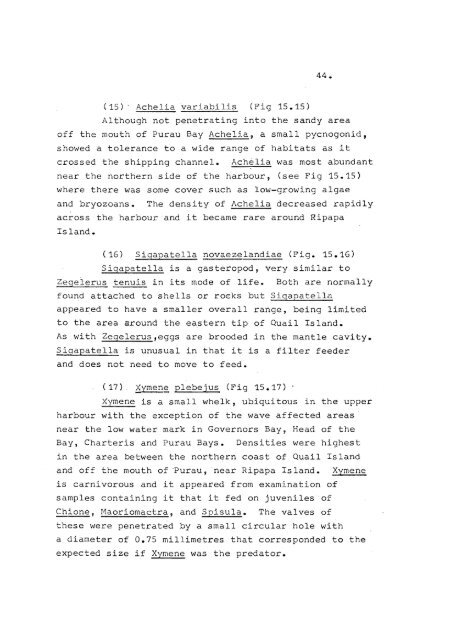The benthic ecology and community structure in Lyttelton Harbour ...
The benthic ecology and community structure in Lyttelton Harbour ...
The benthic ecology and community structure in Lyttelton Harbour ...
You also want an ePaper? Increase the reach of your titles
YUMPU automatically turns print PDFs into web optimized ePapers that Google loves.
44.<br />
(15)' Achelia variabilis (Fig 15.15)<br />
Although not penetrat<strong>in</strong>g <strong>in</strong>to the s<strong>and</strong>y area<br />
off the mouth of Purau Bay Achelia, a small pycnogonid,<br />
showed a tolerance to a wide range of habitats as it<br />
crossed the shipp<strong>in</strong>g channel. Achelia was most abundant<br />
near the northern side of the harbour, (see Fig 15.15)<br />
where there was some cover such as low-grow<strong>in</strong>g algae<br />
<strong>and</strong> bryozoans. <strong>The</strong> density of Achelia decreased rapidly<br />
across the harbour·<strong>and</strong> it became rare around Ripapa<br />
Is l<strong>and</strong>.<br />
(16) Sigapatella novaezel<strong>and</strong>iae (Fig. 15.16)<br />
Sigapatella is a gasteropod, very similar to<br />
Zegeierus tenuis <strong>in</strong> its mode of life. Both are normally<br />
fou~d<br />
attached to shells or ro€ks but Sigapatella<br />
appeared to have a smaller overall range, be<strong>in</strong>g limited<br />
to the area around the eastern tip of Quail Isl<strong>and</strong>.<br />
As with Zegelerus,eggs are brooded <strong>in</strong> the mantle cavity.<br />
Siqapatella is unusual <strong>in</strong> that it is a filter feeder<br />
<strong>and</strong> does not need to move to feed.<br />
, (17). ~ymene plebejus (Fig 15.17) .<br />
Xymene is a small whelk, ubiquitous <strong>in</strong> the upper<br />
harbour with the exception of the wave affected areas<br />
near the low water mark <strong>in</strong> Governors Bay, Head of the<br />
Bay, Charteris <strong>and</strong> Purau Bays. Densities were highest<br />
<strong>in</strong> the area between the northern coast of Quail Isl<strong>and</strong><br />
<strong>and</strong> off the mouth of 'Purau, near Ripapa Isl<strong>and</strong>. Xymene<br />
is carnivorous <strong>and</strong> it appeared from exam<strong>in</strong>ation of<br />
samples conta<strong>in</strong><strong>in</strong>g it that it fed on juveniles of<br />
Chione, Maoriomactra, <strong>and</strong> Spisula. <strong>The</strong> valves of<br />
these were penetrated by a small circular hole with<br />
a. diameter of 0.75 millimetres that corresponded to the<br />
expected size if Xymene was the predator.
















